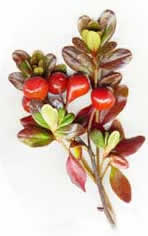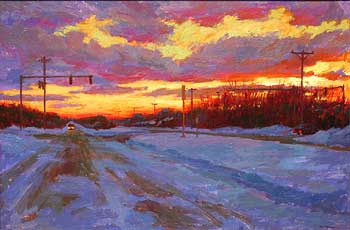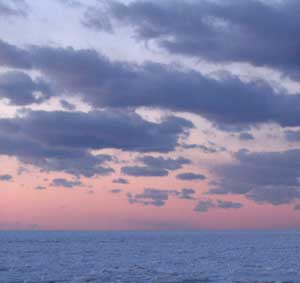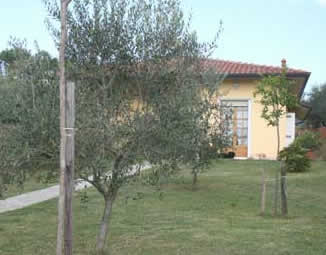


What We Love About Winter
AS WINTER SETTLES over the Cape, gardens and beaches are abandoned for the warmth of life indoors. For me, longer nights invite candlelit rooms, a fire in the hearth, and hours of couch-potato time to catch up on all those shows I’d recorded but never had time to watch during the bustle of summer. I love winter on Cape Cod. It slows me down and gives me time to regroup.

Simie Maryles, "Snow Palace," oil on board
My first taste of a Cape Cod winter was in November, 1989, when I woke up on Thanksgiving morning to find snow covering the bottom half of my window. This was my first winter in the United States after 22 years of English winters, where snowfall was typically measured in inches, not feet. I literally shrieked as I jumped up on the bed to get a better view of this strange new world, where absolutely everything was buried in a pristine blanket of white. Over a foot of snow had fallen overnight.
My raucous shouts woke up my room mate and we hurried into our T-shirts, black leggings, nylon socks and leather ankle boots. We were scheduled to waitress at Captain Parker’s Pub that afternoon, a mere five minute walk from our rented home, but we couldn’t get beyond the front door. Not only were we outstandingly underdressed, but we had never even heard of a snow shovel and had no idea where we would find one. A call to the pub’s owner, Gerry Manning, sent several fellow workers to our rescue with shovels, gloves, snow boots and a sled. We had a blast throwing ourselves into the deep snowdrifts, hurling snowballs at each other and making the best snow angels I’d ever seen. Our cheeks had not thawed out by the time Thanksgiving dinner was served but our excitement at the magic brought by this surprise snowstorm lasted for days.
Snow never surprises me now. I anticipate every snowfall with the excitement of a child; I gather up my snow shovels (I have one for each exit,) stock up the pantry with popcorn, cookies and soups, check the batteries in my flash lights, gather up the firewood, and pile the snow pants, jackets, boots, gloves and hats by the front door.
As the snow falls, I head outside every two to three hours to clear off the doorways, to make a pee-path for my cat and dog, and shovel a line from my front door to my car. My snow clearing routine is one of my favorite things about winter on the Cape, especially if I have to stay up all night to do it. There is a profound silence that hangs in the air when I stop shoveling and just observe the snow falling around me. It feels like the entire world has been forced to stop, take a breath, and enjoy the beauty of the moment. While it is exhausting, it is so rewarding and makes those hours curled up on the couch afterwards all the more luxurious.
— Nicola Burnell, Harwich
We asked several Cape Women what
they love about winter on the Cape.
Here are their replies:
I love sitting in a comfy arm chair at dusk in my quiet living room, with a fragrant cup of tea in a delicate china cup, watching lazy snowflakes fall in the light of a post lantern. — Marie Sherman, Brewster
"I love the cold that comes with winter. Bundled up and walking in the bright sun on the coldest days is the most refreshing feeling. The air feels clear and clean.
The leaves drop off the trees exposing the lines of the tree branches, thousands of interwoven outlines in gray against the purple sky of dusk.
The winter sun, high overhead in the summer, now lower on the horizon, streams into the front porch windows. On the coldest days, I can stretch out on the porch sofa in the warm sun and read. We take the screens out of the windows, and the view outdoors becomes sharp and clear.
The evening starts earlier, as soon as the sky darkens. There is more time for all the things that I like to do indoors, but don’t want to do in the summer when it is warm and light: movies, concerts, dinners, sleeping. Cold weather foods: slow-cooking meats, roasted vegetables, spiced cider, mashed potatoes, pot pies.
My favorite thing about winter, though, is Christmas, because it means having the family together."
— Pat Bertschy, Brewster
"It gives me a feeling of great happiness and pleasure to sit in a comfy recliner, all wrapped up in a "snuggly" blanket, flames roaring in the fireplace. I love to read a wonderful novel while drinking hot cocoa with whipped cream, sprinkled with chocolate bits, glancing out of my eight foot sliders from time to time, watching crystal snow flakes gently come to rest on the already whitened landscape."
—
Anita Caruso, Brewster
"Winter is by far one of my favorite seasons. Yes, it’s cold, but quilts, big sweaters and dressing in layers can fix that problem. Most days are dark, but candles, twinkling lights and the soft glow of cozy interiors can light my way. Winter is always filled with the scents of spiced teas, ginger and warm crackling fires. It’s a time of quiet - refreshing ourselves enough to let our creative spirits fly again."
— Barbara Struna, Brewster

Simie Maryles, "Solitary Traveler," oil on board
"I love the skyscapes and sunsets in the colder weather. I'll never forget my first winter in the US, in Provincetown in 1973, I had never seen anything quite like those vast skies, full of color, reflecting in the glassy water—rosy skies turing the entire bay pink, huge purple clouds with swirling, spiralling wisps of white against apricot and jasmine, turquoise and jade, for how else could I describe those indescribable colors. And those winter skies still amaze me as I gaze in awe at their beauty."
— Gillian Drake, N. Eastham
P. O. Box 720, North Eastham, Cape Cod, MA 02651
Telephone: (508) 255-5084
© Copyright 2008 |
All rights reserved
“There Ain’t No Blues
Like the Wintertime Blues”
That used to be the tune I danced to. I was one of those pathetic wretches who hated winter. The short days. The endless gray. The snowstorms that put the kibosh on my plans. Hate it, hate it, hate it! And that is a lousy attitude for someone who lives north of the Mason/Dixon, where winter drags on endlessly. The calendar says spring and it’s snowing. Alright already.
But my attitude changed in 1999, the year we moved to our new house, located next to a cranberry bog. I’d like to tell you I finally realized the futility of cursing the weather gods (and those blasted meteorologists) and found peaceful acceptance. But no, it was hardly that enlightened. What happened was this. I had a dog, Spooky, a high-spirited husky, and like every dog, she required regular walks. Happily, the bog is dog-walking heaven. We had moved in May and the long bog walks Spooky and I took that spring were grand (except for the mud but that’s another essay). Spring turned to summer and summer to fall and the walks were glorious . . . until Old Man Winter’s inevitable arrival. But you gotta do the dog so up I bundled, and out the door we went—every day, with the exception of a blizzard or two.
The something miraculous happened. After the first few minutes of shivering and quivering (me, not the dog), I didn’t, as feared, freeze to death. I enjoyed being out by the bog. It was quiet. The birds were cooler (figuratively speaking, although maybe literally as well); there were buffleheads and wood ducks and teals, oh my! I noticed the spare beauty of the bare tree branches silhouetted against the eye-popping winter skies. Words like “invigorating,” “clear” and “crisp” became part of my vocabulary, replacing some of the saltier language that typically graced my chapped lips in wintertime. It wasn’t so bad after all. Who knew?
In essence, I had become a “winter person.” I stopped hiding inside, huddled underneath blankets, waiting impatiently for summer. Yes, it is all good . . . except for these horrid short days. I won’t ever get used to that. Look for me by the calendar, crossing off the days until the winter solstice arrives and the days finally, blissfully, begin to lengthen. Amen to that.
Olivia H. Miller lives in Marstons Mills and is
the author of eight exercise and wellness card decks, including The Yoga
Deck, The Stretch Deck and The Healthy Back Deck, which was released in
Spring 08. She also facilitates private and group Stress Buster
Relaxation sessions and Energy Balancing workshops. Olivia was an early contributor to Cape Women Magazine and is
thrilled to see it reappear in its online guise!
www.ohmworks.com
. . . . . . . . . . . . . . . . . . . . . . . . .
Winter's Work
by Anne Garton

"Summer on Cape Cod is for wool-gathering, but winter is for production.
Four years ago it was clear I’d have to do something productive, i.e., creative, with my long Cape winters. I love the Cape in winter, actually, especially when it snows. But you can’t count on snow for continuous amusement and anyway, most of the time it doesn’t snow, or it snows in an unattractive sort of way, and then the Cape grays itself again.
Like so many Cape-ers, I thought I might try my hand at painting, since art is my first love. I started to paint dreamy summer seascapes all through the dead of winter. I never ran out of subject matter. It wasn’t winter that inspired me, it was the Cape summer. But this blustery season gives me something else—the precious gift of time and reflection. And, oddly, winter gives me energy.
All summer I photograph the Cape. I walk the beaches, I hike the trails. I take dune naps. I sleep in hammocks. The wheels are turning, but they don’t go anywhere. I slumber through summer, adding gorgeous images to the old memory bank.
But then, beginning in the fall and right through what passes for spring on the Cape, I am the soul of industry. This is when I plunder that summertime imagery. I think of winter as the alchemy that transforms my sweet summer wool-gathering into art.
Winter, now, is as necessary to me as the summer sky and the sea and Cape Cod itself. Winter is for my work."
—Anne Garton, North Eastham
www.annegarton.com photos by Anne Garton

Simie Maryles, "WInter Afternoon in the Parlor"
www.simiemaryles.com
________________________________________________
Victory Gardens continued:
More food for thought:
•
Eat the View www.eattheview.org
• Kitchen Gardeners International
www.kitchengardeners.org
•The National Gardening Association www.garden.org/ediblelandscaping
• YouTube, Doiron’s video, “This Lawn is Your Lawn”
Gillian Drake is the publisher of this magazine.
Victory Gardens:
The Case for an Edible Landscape
by Gillian Drake

A front garden serves as an "orto," vegetable garden, in Italy
THIS SUMMER, as gasoline prices crested the $4.00 a gallon mark and seemed on an inexorable march northwards, I found myself musing at the number of landscaping vehicles I saw zooming all over the Cape, intent on getting summer homes ready for their owners. You’ve seen them, those zippy little trucks with hoes and rakes and spades sticking out of them, towing a trailer containing a monster mowing machine. I realized, sadly, that these contraptions were destined for acres of bright green lawn and neat weed-free flowers beds. And I thought, how amazing it would be if these young men and women, dashing all over the Cape in such a frenzy, were planting vegetable gardens instead.
It would take the same kind of effort, the same kind of money, but look what we’d get! Enough vegetables for the household, or to sell at the farmers’ markets, give to neighbors, or to bottle, can or freeze for the winter. No lawn pesticides and fertilizers. In fact, no lawns at all to soak up precious summer rain like a sponge. The idea seemed familiar. And then I remembered the name. Victory Gardens. It all seems so last century, but in fact it is an idea whose time has come—again.
In Italy, where I spend part of the year, every front yard is an olive grove or vineyard, every back yard a vegetable garden, bordered with fruit and nut trees. There are no lawns. The Italians would not dream of buying a plant that doesn’t produce; the nurseries are full of olive saplings, fig trees, hazelnuts, walnuts, almonds.
Share a meal with Italians and the main subject of conversation will be food, and that means growing it: the different varieties of grapes they use in their wine, which olive trees produce the best oil, how they salt anchovies, how to use wild borage, where to hunt for the best porcini mushrooms.

A front lawn as olive grove, Italy.
So how did we get to the point where we’ll spend a small fortune on keeping our lawns green and flower beds mulched, but find it challenging to grow a few tomatoes in a pot on the patio? When did vegetable gardening become something only the crunchy-granola brigade did, something that was kind of weird? Or maybe it’s a status thing, as in those with money can afford to have emerald-green lawns and pay for them to be cared for.
The original idea of the Victory Garden was that produce from urban and suburban gardens would help provide the nutritious food needed by soldiers during WWII. It helped to keep the price of food low, so the War Department would have more money to spend on other military needs. The Victory Gardens also helped solve the shortages of labor and transportation that made it difficult to harvest and transport produce to market. One poster from the mid 1940s read: “Our food is fighting,” portraying the high sense of patriotism so characteristic of the time.
The Department of Agriculture, along with agribusiness corporations, distributed booklets providing information about basic gardening techniques. First Lady Eleanor Roosevelt inspired millions to grow their own food during the war. In 1943, 20 million gardens were producing 8 million tons of food. Victory Gardens were planted in back yards, front yards, on apartment building roofs, in vacant lots, and pretty much in every available patch of dirt and container throughout the U.S., Canada, and the U.K. Neighbors pooled their resources, planted different kinds of foods, and formed cooperatives, doing whatever had to be done to produce food.
Magazines printed stories about Victory Gardens, and women’s magazines provided instructions on how to grow and preserve garden produce. Sales of pressure cookers skyrocketed as families were encouraged to can their own vegetables. The government as well as businesses urged families to make gardening a group effort; even children and teenagers willingly took part in the work of the garden. At the peak of the effort, the produce from Victory Gardens produced an amount equal to all commercial production.
The idea of the Victory Garden was clearly a victory on many levels, and now it is back in style. Today we are again involved in fighting a battle, but this time trying to stay healthy in a world where commercially grown produce comes from soils depleted of the minerals and nutrients so necessary to keep us healthy in our polluted and stressful environment. Plants grown in depleted soils are less healthy and less able to resist attack by pests, so the use of pesticides is more prevalent than ever. Much of our Agribusiness produce is now being grown in foreign countries not subject to highly controlled use of pesticide. Today’s big food corporations choose the cheapest, most effective pesticides, not the ones that are least toxic to humans and other life forms. Along with pesticide residues, our produce contains residual amounts of synthetic chemical fertilizers which are toxic to our livers.
High gasoline prices ensure that the price of food will continue to increase in the coming months. We wonder how we will be able to continue buying quality foods to keep us healthy. Fruits and vegetables often travel 1500 miles before they reach the supermarkets. Produce is picked without having a chance to ripen so it can withstand the long trip to market. During this process, even more of the nutrients are lost. When it finally reaches the supermarket, produce can sit in cold storage for a week before being put out for sale.
One person who has taken this idea of an edible landscape seriously is Roger Doiron, of Scarborough, Maine. He calls his vision “Eat the View,” and says “People are starting to rethink what a healthy landscape looks like. It’s not the TruGreen chemical lawn anymore. It’s a landscape that’s more multipurpose, that combines beauty and utility.” Fans are signing an online petition on Doiron’s web site (www.eattheview.org) and watching his entertaining video on YouTube which chronicles his front lawn being transformed into a vegetable garden.
Yes, it takes time and effort, but how much more healthy it is for us to work in the garden in summer evenings, rather than watch TV or go to the gym after work. Once the bed is dug and planted, it only takes 30 minutes a day—a bit of weeding, switching on the watering system—to have fresh produce all summer. There are few things more satisfying, or more healthy, than taking your salad bowl out into the garden and filling it with fresh lettuce leaves, tomatoes and other salad veggies, picked fresh, full of nutrients, devoid of harmful chemicals, and tasting terrific.
Now that the food we are being offered in supermarkets is actually harmful to our health, instead of being healthful, and organic food is sometimes fraudulently mislabeled, it seems all the more crucial that we redefine our relationship to food and our understanding of its natural origins. With talk of GM modification, irradiation, and all the chemicals used in the growing process, we would do best to steer clear of them and only eat food that we, or our neighbors, or local farms, produce.
continued on left hand column . . .